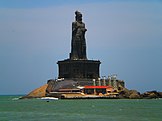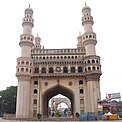South India
Peninsular India | |
|---|---|
 States and union territories in South India | |
| Country | |
| States and union territories | |
| Most populous cities | |
| Area | |
• City | 635,780 km2 (245,480 sq mi) |
| Highest elevation (Anamudi) | 2,695 m (8,842 ft) |
| Lowest elevation (Kuttanad) | −2.2 m (−7.2 ft) |
| Population (2011) | |
• City | 253,051,953 |
| • Density | 400/km2 (1,000/sq mi) |
| • Urban | 111,386,832 |
| Demonym(s) | South Indian Telugu Tamilian Kannadiga Malayali Laccadivian Pondicherrian |
| Time zone | IST (UTC+5:30) |
| Official languages[1] | |
| HDI (2019) | |
| Literacy (2011) | 76.43%[2] |
| Sex ratio (2011) | 986 ♀/1000 ♂[3] |
South India, also known as Southern India or Peninsular India, is the southern part of the Deccan Peninsula in India encompassing the states of Andhra Pradesh, Karnataka, Kerala, Tamil Nadu and Telangana as well as the union territories of Lakshadweep and Puducherry, occupying 19.31% of India's area (635,780 km2 or 245,480 sq mi) and 20% of India's population. It is bound by the Bay of Bengal in the east, the Arabian Sea in the west and the Indian Ocean in the south. The geography of the region is diverse, with two mountain ranges, the Western and Eastern Ghats, bordering the plateau heartland. The Godavari, Krishna, Kaveri, Penna, Tungabhadra and Vaigai rivers are important non-perennial sources of water. Chennai, Bangalore, Hyderabad, Coimbatore and Kochi are the largest urban areas in the region.
The majority of the people in South India speak at least one of the four major Dravidian languages: Telugu, Tamil, Kannada and Malayalam. During its history, a number of dynastic kingdoms ruled over parts of South India, and shaped the culture in those regions. Major dynasties that were established in South India include the Cheras, Cholas, Pandyas, Pallavas, Satavahanas, Chalukyas, Hoysalas, Rashtrakutas and Vijayanagara. European countries entered India through Kerala and the region was colonized by Britain, Portugal and France.
After experiencing fluctuations in the decades immediately after Indian independence, the economies of South Indian states have registered a sustained higher-than-national-average growth over the past three decades. South India has the largest combined largest gross domestic product compared to other regions in India. The South Indian states lead in some socio-economic metrics of India with a higher HDI as the economy has undergone growth at a faster rate than in most northern states. As of 2011, Literacy rates in the southern states is higher than the national average at approximately 76%. The fertility rate in South India is 1.9, the lowest of all regions in India.
- ^ Indian languages (PDF) (Report). Ministry of Education, Government of India. Archived (PDF) from the original on 28 May 2023. Retrieved 30 August 2023.
- ^ "Census 2011, States". Government of India. Archived from the original on 28 November 2018. Retrieved 9 September 2020.
- ^ Census 2011 (Final Data) – Demographic details, Literate Population (Total, Rural & Urban) (PDF) (Report). Planning Commission, Government of India. Archived from the original (PDF) on 27 January 2018. Retrieved 3 October 2018.






